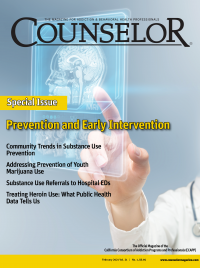Share

The role of the counselor in substance use disorder (SUD) and co-occurring disorder (COD) treatment involves competency in client, family, and community education (SAMHSA, 2017), which, although not specifically stated, involves advocacy. Certainly, professionals in the industry are actively involved in advocating for their specific clients, but advocating for the development of programs in the community that help those we serve is also important. As professionals pursue the latter, challenges that may arise include the phenomenon of NIMBYism (Dear, 1992).
NIMBY, the acronym for “Not in My Backyard” is defined as the almost knee-jerk reaction of opposition to a project of any type and in any industry (“NIMBY,” n.d.). This response may come from one or more members of a community that will be affected. Commonly arising when affordable housing projects are planned (Tracey, 2019; Wassmer & Wahid, 2019), NIMBYism also affects projects related to SUD prevention, treatment, and recovery (Nenn, 2019). There is a good possibility that you are aware of this type of effort in your town or city.
Combatting NIMBYism is a form of advocacy from both the profession and those in the recovery movement with lived experience (not mutually exclusive). In his 2000 paper “Towards a New Recovery Movement: Historical Reflections on Recovery, Treatment, and Advocacy,” William White identifies a series of five kinetic ideas for the recovery advocacy movement, two of which apply directly to what we are trying to accomplish in the face of NIMBYism: “Recovery flourishes in supportive communities” and “Recovering and recovered people are part of the solution; recovery gives back what addiction has taken” (p. 13). Although these ideas are directed at individuals in recovery, they can be applied to the profession as well. White himself wrote that in order “to be successful, the core concepts of recovery advocacy movements must ‘work’ at personal, professional, community and cultural levels” (2000, p. 13).
Community opposition to much- needed recovery resources—whether treatment facilities, recovery community organization sites, or recovery housing—can be frequent, fierce, and rife with significant and palpable tensions. Our natural response may be to look at the NIMBY set from the classic Alinsky (1971) view (i.e., see them as the enemy) and relentlessly attack, but responding in kind would simply create even greater resistance (Manuel, 2018). It would benefit us greatly if instead we viewed them as change partners (Manuel, 2018) in order to garner acceptance and cooperation. Many of us have learned that approach is often effective, given our training and practice of motivational interviewing (MI; Miller & Rollnick, 2012). To elicit change, meeting someone “where they are, not where we want them to be” (Warpehoski, 2016) is paramount. If we are to facilitate community change, do we not need to understand the community? More importantly, do we not need to understand the issue from their perspective?
Lessons in turning the tide of NIMBYism come from an unusual and ancient source, the translated 2,500-year-old writings of Sun Tzu encapsulated in The Art of War (Tzu & Giles, 1910/2020) that have been applied not only to war, but to business, athletics, and other areas. Some quotes of his work with scholarly interpretation include the following.
- “The greatest victory is that which requires no battle”: Diplomacy should always be our first option and shows that not every situation has a winner and a loser (Parmar, 2020). The hard work of diplomacy can create winners on both sides of the issue. It can stimulate discussion, understanding, and opportunities for positive change.
- “If you know the enemy and you know yourself, you need not fear the result of a hundred battles”: Knowing your “enemy” requires understanding their point of view and their concerns (Parmar, 2020). Are they worried about safety, the values of their homes, or housing code violations that aesthetically mar the community? If we look at this from the perspective of the community members, many of these concerns may be legitimate and all must be treated as such. The MI (Miller & Rollnick, 2012) skills of reflective listening and asking open-ended questions prove invaluable in this regard. In addition, if we encourage the same from the NIMBY set, they also learn not only our perspectives, but valuable information about our motivation. It has tremendous impact on our ability to apply diplomacy in lieu of a fight. Making enemies of those who are not erases that opportunity (Parmar, 2020).
Speaking of the opportunities that diplomacy creates, Sun Tzu (1910/2020) also believed that one opportunity often begat others. For example, if we work with the community to establish what it is we are seeking, are we also not creating the opportunity for our project to be good neighbors and a positive part of the community? Does the willingness to work collaboratively to meet the needs of those we serve not open up other opportunities for collaboration?
Just as MI (Miller & Rollnick, 2012) has taught us that in order to obtain lasting change and gain understanding, we must change how we look at a problem, so we must also change the way we look at NIMBYism. Rather than looking at it according to the classic definition previously noted in this article, we must expand that to include the community’s view of the “problem” of adding projects of the SUD prevention, treatment, and recovery industry to their “backyard.” Although the lion’s share of this advocacy will fall on an organizational level, there is a responsibility to the profession and those served that we should accept as individual practitioners. We can, as professionals and possibly even neighbors (but not as employees or representatives of a specific organization without proper authorization), put a positive face on recovery, the recovery community, and the recovery professions. In short, we should advocate from a recovery orientation.
Of course, we should be sure that the things we have advocated for (e.g., our programs, residences, and other related projects) remain good neighbors, including remaining open for community feedback and discussion. Advocacy, whether in the face of NIMBYism or any other concern relating to the needs of people in recovery and the programs that serve them, is not a time-limited task. It is important to recognize we will be continually evaluated (if not judged) by the community, so our actions must remain in alignment with our words and promises. We represent our clients, our employers, and the profession, and our behaviors can have a larger impact. Whether right or wrong, our behaviors while advocating for a cause may affect the perception of our profession (and potentially those we serve) as a whole. It is not just our responsibility to advocate in the face of NIMBYism, but to do so while respecting the community at large.
References
Alinsky, S. D. (1971). Rules for radicals: A practical primer for realistic radicals. New York, NY: Random House.
Dear, M. (1992). Understanding and overcoming the NIMBY syndrome. Journal of the American Planning Association, 58(3), 288–300.
Manuel, T. (2018). Triumph over NIMBY attitudes is not only possible, but necessary. Retrieved from https://www.naco.org/articles/triumph-over-nimby-attitudes-not-only-possible-necessary
Miller, W. R., & Rollnick, S. (2012). Motivational interviewing: Helping people change (3rd ed.). New York, NY: Guilford Press.
Nenn, K. (2019). Here’s how the NIMBY attitude crushes recovery expansion. Retrieved from https://www.rehabs.com/blog/heres-how-the-nimby-attitude-crushes-recovery-expansion/
“NIMBY.” (n.d.). Retrieved from http://nimby.com/
Parmar, A. (2020). Ten quotes from “The Art of War” that will transform your life. Retrieved from https://medium.com/live-your-life-on-purpose/10-quotes-from-the-art-of-war-that-will-transform-your-life-a571381f57c8
Substance Abuse and Mental Health Services Administration (SAMHSA). (2017). Addiction counseling competencies: The knowledge, skills, and attitudes of professional practice. Technical assistance publication series (TAP) 21 (pp. 131–9). Retrieved from https://store.samhsa.gov/sites/default/files/d7/priv/sma12-4171.pdf
Tracey, M. D. (2019). Carson: NIMBY should no longer be an issue for affordable housing. Realtor Magazine. Retrieved from https://magazine.realtor/daily-news/2019/02/22/carson-nimby-should-no-longer-be-an-issue-for-affordable-housing?utm_source=feedburner&utm_
medium=feed&utm_campaign=Feed%3A+DailyRealEstateNews+%28Daily+Real+Estate+News%29
Tzu, S. (Author), & Giles, L. (Translator). (1910/2020). The art of war. London, UK: Arcturus.
Warpehoski, C. (2016). Seven principles of community organizing. Retrieved from http://www.icpj.org/blog/wp-content/uploads/2016/07/7-Principles-of-
Community-Organizing.pdf
Wassmer, R. W., & Wahid, I. (2019). Does the likely demographics of affordable housing justify NIMBYism? Housing Policy Debate, 29(2), 343–58.
White, W. (2000). Toward a new recovery advocacy movement. Presented at Recovery Community Support Program Conference “Working Together for Recovery,” April 3–5, 2000, in Arlington, VA. Retrieved from http://www.williamwhitepapers.com/pr/2000TowardaNewRecoveryMovement.pdf
About Me
Jeffrey Quamme, MS, CAC, CCS, CNC, CNE, is the executive director of the Connecticut Certification Board, a workforce development organization for SUD/COD professionals. He is an administrator, trainer, and podcast host and has served as a subject matter expert for legislative office at the federal level.














 Counselor Magazine is the official publication of the California Association of Addiction Programs and Professionals (CCAPP). Counselor offers online continuing education, article archives, subscription deals, and article submission guidelines. It has been serving the addiction field for more than thirty years.
Counselor Magazine is the official publication of the California Association of Addiction Programs and Professionals (CCAPP). Counselor offers online continuing education, article archives, subscription deals, and article submission guidelines. It has been serving the addiction field for more than thirty years.